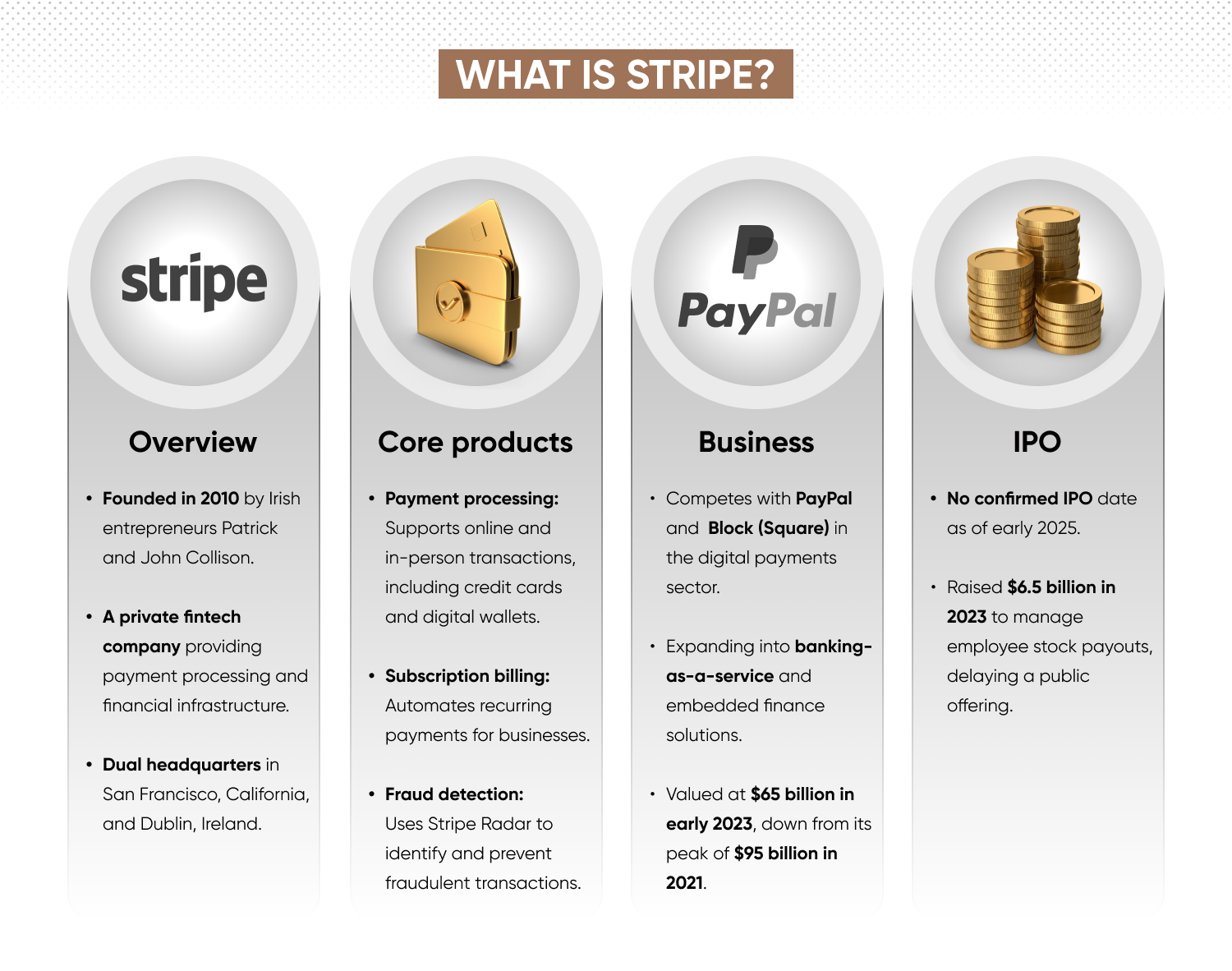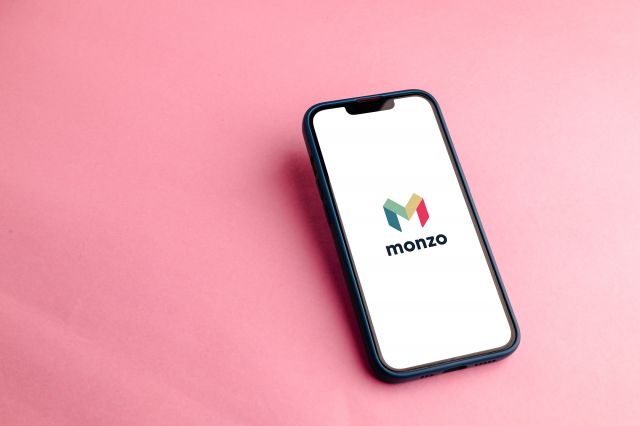Stripe IPO – how to trade Stripe shares

Discover more about Stripe's anticipated IPO, explore key factors that could influence its share price, and find out how to trade tech stocks via CFDs.
When is the Stripe IPO?
Stripe hasn’t announced an official date for its initial public offering (IPO). As of January 2025, the company remains privately held despite ongoing speculation about a potential listing.
Reports indicate that Stripe has explored multiple IPO options, including a direct listing or a traditional public offering. In 2025, the online payments company was valued at around $91.5 billion – significantly lower than its 2021 peak valuation of $95 billion. While this fundraising move delayed an IPO, it also indicates that Stripe may eventually seek public markets to secure long-term capital.
In the absence of a confirmed IPO timeline, traders interested in the fintech sector might research publicly listed competitors such as PayPal, or other payment processing companies.
What is Stripe?
Stripe is a private financial technology company that provides payment processing and financial infrastructure for businesses. Founded in 2010 by Irish entrepreneurs Patrick and John Collison, Stripe has dual headquarters in San Francisco, California, and Dublin, Ireland.
Stripe’s platform enables businesses to accept online and in-person payments, manage revenue, and streamline financial operations – supporting credit and debit card transactions, and digital wallets like Apple Pay and Google Pay. Beyond payment processing, Stripe offers services including subscription billing, fraud detection with Radar, and business financing via Stripe Capital.
Despite long-running IPO speculation, Stripe remains privately held. In early 2023, the company was valued at approximately $65 billion, down from its peak valuation of $95 billion in 2021.

What might influence the Stripe live stock price?
Stripe’s live stock price – if it goes public – could be shaped by various factors, including transaction volume, competitive pressures, regulatory developments, and broader market sentiment.
Revenue growth and transaction volume
Stripe earns revenue from the fees it charges when a transaction is made on its platform, its performance may be influenced by online spending patterns and global e-commerce trends
For example, digital payments surged during the COVID-19 pandemic, contributing to Stripe’s peak valuation of $95 billion in 2021. However, as e-commerce growth slowed in 2022-2023 and high inflation affected consumer spending, the company’s valuation dropped to around $65 billion following its 2023 funding round. A continued slowdown in online transactions, particularly in key markets like the US and Europe, could weigh on Stripe’s potential stock price.
Competitive landscape
Stripe competes with PayPal and Block in digital payments, a niche of the fintech sector. As a result, Stripe’s stock price could be affected by shifts in market share, new product launches, or strategic partnerships within the industry. If a competitor introduces lower-cost processing solutions or secure exclusive partnerships with major merchants, Stripe’s competitive edge could weaken.
Conversely, innovations such as enhanced fraud detection, embedded finance solutions, or improved developer tools may strengthen Stripe’s position. The success of its banking-as-a-service and financing products – such as Stripe Treasury and Stripe Capital – could also impact sentiment.
Regulatory and legal developments
Stripe is subject to regulatory oversight across multiple jurisdictions. Changes to payment regulations, data privacy laws, or anti-money laundering (AML) requirements could introduce compliance costs or operational constraints.
If governments impose stricter rules on digital payments or cross-border transactions, Stripe may need to adjust its business model. The outcomes of ongoing legal challenges, such as disputes over interchange fees or compliance with consumer protection laws, could also influence market perception.
Macroeconomic factors and interest rates
During periods of strong economic growth, businesses tend to expand, driving higher payment volumes and potentially boosting Stripe’s revenue. However, economic downturns, inflation, or rising interest rates could reduce consumer and business spending, potentially impacting Stripe’s stock price.
As a high-growth tech company, Stripe’s valuation may also be sensitive to shifts in sentiment towards the broader fintech sector. If interest rates remain elevated, growth stocks may face downward pressure as traders might opt for more stable, income-generating assets.
Market sentiment towards fintech IPOs
The success of other fintech IPOs could provide insights into how Stripe might be received by public markets. If recent fintech listings, such as those of rival payment processors or banking-as-a-service providers, perform well, it could indicate strong demand.
However, if similar companies struggle post-IPO – whether due to revenue volatility, regulatory scrutiny, or profitability concerns – it may negatively impact Stripe's stock price. Market sentiment towards fintech and payments companies could also play a part in determining Stripe’s post-IPO market valuation.

How to trade Stripe stocks
If, and when, Stripe debuts on the stock market, there’s a few steps to take before in order to trade shares.
- Choose a brokerage platformSelect a reliable broker that provides Stripe shares for trading. Capital.com gives access to thousands of assets via contracts for difference (CFDs), allowing speculation on price movements without owning the underlying share.
- Set up a trading accountOpen an account with your chosen platform, providing relevant personal information, including identity verification.
- Deposit fundsFund your account using your chosen method. Ensure you have sufficient capital for your trades, and never trade more than you can afford to lose.
- Monitor stock performanceOnce listed, track Stripe’s stock using real-time data. Follow the company’s news and financial releases that could affect its share price.
- Place a tradeWhen ready, place a market or limit order to buy shares. Consider using stop-loss orders and take profit to limit potential losses, while protecting your gains.
Learn more about contracts for difference in our CFDs trading guide.
Which fintech stocks can I trade?
While Stripe remains privately held with no confirmed IPO date, traders can still gain exposure to the broader fintech sector by trading publicly listed companies that operate in digital payments, financial services, and financial technology infrastructure.
PayPal (PYPL)
PayPal is one of the largest and most recognised digital payment platforms worldwide. The company enables online transactions for consumers and businesses and owns Venmo, a leading peer-to-peer payment app in the US. PayPal provides buy now, pay later (BNPL) services, cryptocurrency transactions, and business lending solutions.
Block (SQ)
Formerly known as Square, Block operates a diverse range of financial services, including its signature point-of-sale (POS) system, business lending solutions, and Cash App, a mobile payment and investing platform. The company has expanded into blockchain and cryptocurrency through its subsidiary, Spiral. Block competes directly with Stripe in payment processing for merchants.
Visa (V) and Mastercard (MA)
Visa and Mastercard dominate the global card payment industry, processing billions of transactions annually. As payment networks, their infrastructure underpins many digital transactions, including those processed by companies like Stripe. Both Visa and Mastercard provide a range of products and services, including contactless payments, e-commerce, and open banking.
SoFi Technologies (SOFI)
SoFi Technologies is a digital banking and personal finance company that offers student loan refinancing, personal lending, credit cards, and investment services. Unlike traditional banks, SoFi operates exclusively online and has expanded its fintech ecosystem with stock trading, cryptocurrency transactions, and a business banking division.
Learn more about trading shares on fintech stocks and more. Check out our comprehensive shares trading guide.
How long until I can trade Stripe shares?
Stripe remains a private company, meaning its shares aren’t yet available for public trading. Until the company announces and concludes its IPO, traders can’t buy or sell Stripe stock through traditional exchanges or via CFDs.
While there’s speculation about a potential listing, Stripe hasn’t set a definitive timeline for its IPO. The company has previously explored options such as a direct listing or traditional public offering, but no formal plans have been confirmed.
For those looking to gain exposure to the digital payments sector, alternatives include publicly traded companies such as Visa and Mastercard, which dominate global card transactions, or Block, which operates Square and Cash App. Additionally, traders can track companies that rely on Stripe’s payment infrastructure, like Amazon.
If Stripe proceeds with an IPO, further details on its share structure, listing exchange, and trading availability will be released. Until then, Stripe stock trading remains unavailable.
FAQs
What is the Stripe IPO date?
Stripe hasn’t announced an official date for its initial public offering (IPO). While there’s ongoing speculation, the company remains privately held. Any IPO announcement will include details such as the listing exchange and share pricing.
How do I trade or invest in Stripe before its IPO?
Until Stripe goes public, its shares aren’t available for trading on stock exchanges, nor through CFD platforms. Some institutional traders may access Stripe shares via secondary private markets, but these opportunities are typically limited to accredited investors. Traders seeking exposure to the fintech sector might consider publicly listed companies such as PayPal or Block – which are accessible through CFD platforms – providing opportunities to speculate on price movements without owning the underlying shares.
Will Stripe shares be available for CFD trading?
If Stripe proceeds with a public listing, its shares may become available for trading via CFDs, depending on the broker’s offering. Traders should check with their CFD provider to see if Stripe will be included as a tradable instrument post-IPO.
Discover more upcoming IPOs
Stay informed on upcoming IPOs, market trends, and the newest trading opportunities

eToro IPO
